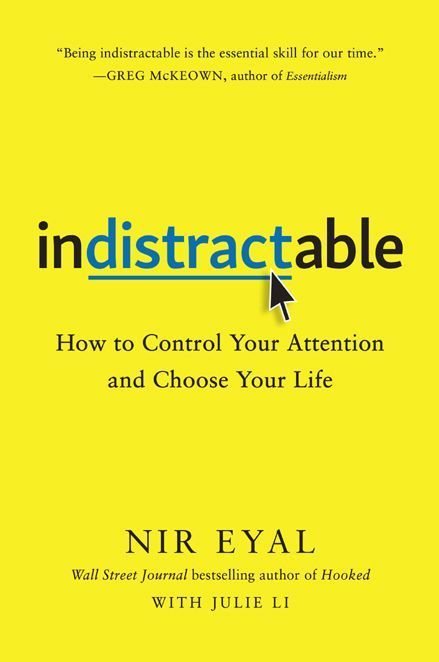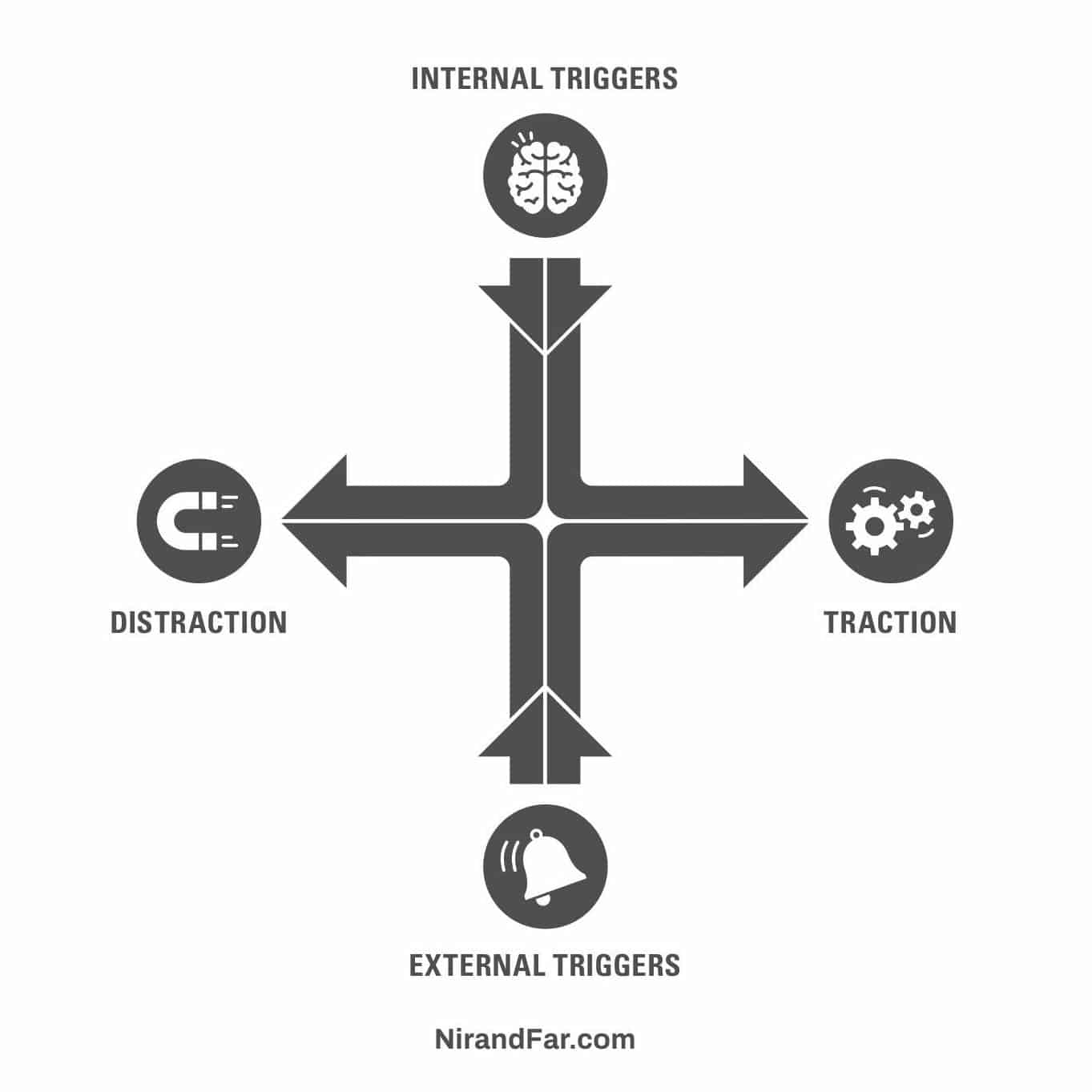Indistractable by Nir Eyal - Summary and Book Notes
This is a summary of a great Tree Book. Tree books are books that lay out a framework of ideas. Here Nir Eyal explores what it means to be Indistractable, and how to achieve that in our hyper-connected world.
Review -- Indistractable by Nir Eyal
I almost didn't read this book. On first glance I thought it'd be another collection of tips and tricks for avoiding your phone--block websites, turn off push notifications, go live in a log cabin to reclaim your attention and your life from being hacked by evil social media platforms. The usual.
Not that those tools aren't useful, but they only mask symptoms instead of addressing root causes. Ultimately you find a way around the blocker, or get distracted by something else.
One of my coaching clients wanted to try some of the workbook exercises included with Indistractable (available here). I was pleased to see that Eyal had gone beyond simple tactics and developed a deeper, more thorough model of distraction.
So I picked up the book. Eyal dives straight in to the psychology behind distraction, noting that most of our behavior is caused by pain avoidance, not pleasure seeking. He claims, "only by understanding our pain can we begin to control it and find better ways to deal with negative urges."
Eyal develops his model and shows you how to become an indistractable person in a clear way, with a good mix of ideas and tactics. He only layers on the website-blocker advice after developing solid fundamentals, which is where it should be. Solid read.

I highly recommend for people who:
- have tried website blockers and the like but still get distracted
- struggle to align their time-spent with their values
- beat themselves up for not being productive
Skip this book if you:
- are generally satisfied with how you spend your time
- are well-versed in the psychology of distraction
Buy Indistractable on Amazon
Quick Takeaway: Four key strategies for becoming Indistractable
Mastering internal triggers
Internal triggers prompt you to action with cues within you.
- Handling discomfort
- Learn to make the boring fun
- Shape your own identity
Hacking back external triggers
External triggers prompt you to action with cues in your environment.
- Reduce external triggers that create distraction
- Use external triggers to generate traction
Making time for traction
Traction leads you closer to your goals. It is any action that moves you toward what you really want.
- Timeboxing - schedule time to work on your values
- Reflect and Revise weekly
- Never bail on appointments you make for yourself
Preventing distraction with pacts
- Effort pacts
- Price pacts
- Identity Pacts

Want to level up your productivity and start getting work done?
We built an interactive coach, available 24⁄7 to give you a feasible next step to improve your productivity skills.
Get the Digital Productivity Coach
Indistractable Book Notes
The following are rough notes I took while reading. These are mostly paraphrased or quoted directly from the book. I've rearranged some ideas from their original book order to better fit themes.
Distraction isn't just about the tech
I kept getting distracted, even without the tech that I thought was the source of the problem.
It's not pleasure seeking, it's pain avoidance
Motivation has much less to do with pleasure than was once thought. Even when we think we’re seeking pleasure, we’re actually driven by the desire to free ourselves from the pain of wanting.
Simply put, the drive to relieve discomfort is the root cause of all our behavior, while everything else is a proximate cause.
Solely blaming a smartphone for causing distraction is just as flawed as blaming a pedometer for making someone climb too many stairs.
Only by understanding our pain can we begin to control it and find better ways to deal with negative urges.
We won't ever be fully happy
Why are we perpetually restless and unsatisfied? We live in the safest, healthiest, most well-educated, most democratic time in human history, and yet some part of the human psyche causes us to constantly look for an escape from things stirring inside us.
Sorry to say, but odds are you and I are never going to be fully happy with our lives.
Review of General Psychology notes, “If satisfaction and pleasure were permanent, there might be little incentive to continue seeking further benefits or advances."
Four psychological factors make satisfaction temporary.
- Boredom
- Negativity Bias
- Rumination
- Hedonic Adaptation
Dissatisfaction is responsible for our species’ advancements and its faults. To harness its power, we must disavow the misguided idea that if we’re not happy, we’re not normal—exactly the opposite is true.
How to handle discomfort
Bricker's Acceptance and Commitment Therapy (ACT)
At the heart of the therapy is learning to notice and accept one’s cravings and to handle them healthfully. Instead of suppressing urges, ACT prescribes a method for stepping back, noticing, observing, and finally letting the desire disappear naturally.
An endless cycle of resisting, ruminating, and finally giving in to the desire perpetuates the cycle and quite possibly drives many of our unwanted behaviors.
We can manage distractions that originate from within by changing how we think about them. We can reimagine the trigger, the task, and our temperament.
Step 1: Look for the Discomfort that precedes the distraction, focusing in on the internal trigger
Step 2: Write down the trigger
He recommends noting the time of day, what you were doing, and how you felt when you noticed the internal trigger that led to the distracting behavior “as soon as you are aware of the behavior,”
Step 3: Explore your sensations
Bricker encourages staying with the feeling before acting on the impulse.
“imagine you are seated beside a gently flowing stream,” he says. “Then imagine there are leaves floating down that stream. Place each thought in your mind on each leaf. It could be a memory, a word, a worry, an image. And let each of those leaves float down that stream, swirling away, as you sit and just watch.”
Step 4: Beware of liminal moments
Liminal moments are transitions from one thing to another throughout our days.
“ten-minute rule.” If I find myself wanting to check my phone as a pacification device when I can’t think of anything better to do, I tell myself it’s fine to give in, but not right now. I have to wait just ten minutes.
“surfing the urge.” When an urge takes hold, noticing the sensations and riding them like a wave—neither pushing them away nor acting on them—helps us cope until the feelings subside.
“It’s a curious truth that when you gently pay attention to negative emotions, they tend to dissipate—but positive ones expand.” -- Oliver Burkeman
Reimagine the Task
Bogost makes several bold claims that challenge the way we think about fun and play. “Fun,” he writes, “turns out to be fun even if it doesn’t involve much (or any) enjoyment.”
Play can be part of any difficult task, and though play doesn’t necessarily have to be pleasurable, it can free us from discomfort—which, let’s not forget, is the central ingredient driving distraction.
Bogost tells us that “fun is the aftermath of deliberately manipulating a familiar situation in a new way.” The answer, therefore, is to focus on the task itself. Instead of running away from our pain or using rewards like prizes and treats to help motivate us, the idea is to pay such close attention that you find new challenges you didn’t see before.
Read my article on making boring fun
Ego Depletion, Belief, Identity
Dweck concluded that signs of ego depletion were observed only in those test subjects who believed willpower was a limited resource.
People who did not see willpower as a finite resource did not show signs of ego depletion.
Michael Inzlicht, professor of psychology, believes that willpower is not a finite resource but instead acts like an emotion.
What we say to ourselves is vitally important. Labeling yourself as having poor self-control actually leads to less self-control.
Being indistractable means striving to do what you say you will do.
Just as you wouldn’t blow off a meeting with your boss, you should never bail on appointments you make with yourself.
It doesn’t so much matter what you do with your time; rather, success is measured by whether you did what you planned to do.
An identity pact is a precommitment to a self-image. You can prevent distraction by acting in line with your identity.
Though we often assume our identity is fixed, our self-image is, in fact, flexible and is nothing more than a construct in our minds.
External Triggers
Receiving a cell phone notification but not replying to it was just as distracting as responding to a message or call.
If the trigger helps us do the thing we planned to do in our schedule, it’s helping us gain traction. If it leads to distraction, then it isn’t serving us.
Whether it’s a vest, a screen sign, or a light-up crown, the way to reduce unwanted external triggers from other people is to display a clear signal that you do not want to be interrupted.
Hack Back Email and Chat
Email:
- Reduce the number of messages received.
- Schedule office hours, delay when messages are sent, and reduce time-wasting messages from reaching your inbox.
- Spend less time on each message.
- Label emails by when each message needs a response. Reply to emails during a scheduled time on your calendar.
Chat:
- Use it like a sauna (in and out quickly)
- Schedule it on your timeboxed calendar
- Be picky with who is in the group chat (the fewer people the better)
- Use it selectively (opt for in person when mood, tone, and nonverbal signals add critical context)
Meetings:
- Require two things of anyone who calls one.
- First, meeting organizers must circulate an agenda of what problem will be discussed. No agenda, no meeting.
- Second, they must give their best shot at a solution in the form of a brief, written digest.
Hack Back Your Smartphone
- Remove apps you don't need
- Replace apps with desktop equivalents or other objects (watch, alarm clock, etc)
- Rearrange apps to show tools and hide slot machines
- Reclaim notifications - be very selective regarding which apps can push notifications
- Reward walks or exercise with online articles (text to speech)
Hack Back Your Desktop
- Remove clutter from view
- Use Instapaper or Pocket. Never read an article in the browser.
- Use FB news feed eradicator, DF Tube, Open twitter notifications directly instead of starting with the main feed
Timeboxing
Does your calendar reflect your values? To be the person you want to be, you have to make time to live your values.
Schedule time to work on your values
The goal is to eliminate all white space on your calendar so you’re left with a template for how you intend to spend your time each day.
It doesn’t so much matter what you do with your time; rather, success is measured by whether you did what you planned to do.
Reflect and Revise weekly
Read my article on scheduling your day
Control the Inputs; Prioritize "You" time
Just as you wouldn’t blow off a meeting with your boss, you should never bail on appointments you make with yourself.
We can start by prioritizing and timeboxing “you” time. At a basic level, we need time in our schedules for sleep, hygiene, and proper nourishment.
We tend to think we can solve our distraction problems by trying to get more done each minute, but more often the real problem is not giving ourselves time to do what we say we will.
The people you love deserve more than getting whatever time is left over. If someone is important to you, make regular time for them on your calendar.
Sync your schedule with stakeholders at work. schedule syncing is essential, whether with a family member or an employer. Regularly aligning expectations around how you’ll spend your time is paramount, and must be done in regular, predictable increments.
Pacts
Focus not only requires keeping distraction out; it also necessitates keeping ourselves in.
The most effective time to introduce a precommitment is after we’ve addressed the first three aspects of the Indistractable Model.
An effort pact prevents distraction by making unwanted behaviors more difficult to do. Apps like SelfControl, Forest, and Focusmate can help you make effort pacts.
A price pact is a type of precommitment that involves putting money on the line to encourage us to do what we say we will. Stick to your intended behavior, and you keep the cash; but get distracted, and you forfeit the funds.
An identity pact is a precommitment to a self-image. You can prevent distraction by acting in line with your identity.
By thinking of yourself as indistractable, you empower yourself through your new identity. You can also use this identity as a rationale to tell others why you do “strange” things like meticulously plan your time, refuse to respond to every notification immediately, or put a sign on your screen when you don’t want to be disturbed. These acts are no more unusual than other expressions of identity, like wearing religious garb or eating a particular diet. It’s time to be indistractable and proud!
The book closes out with sections on building healthy work culture, and raising indistractable children. Worth a closer look if these topics are relevant to you.
Buy Indistractable here.
Further Reading
- Digital Minimalism by Cal Newport
- Stillness is the Key by Ryan Holiday
- Work Clean by Dan Charnas
- Boring is Fun
- Plan Your Day




Member discussion